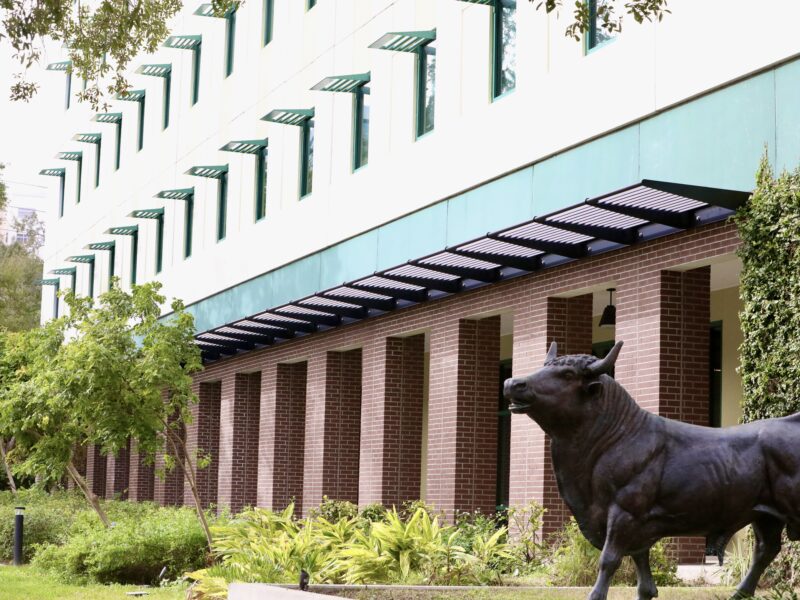Pictured Above: Taniya Tinsley is a senior marketing major at USF St. Petersburg.
Courtesy of Taniya Tinsley
By Taniya Tinsley
In March, a 26-year-old emergency medical technician named Breonna Taylor was shot at least eight times and killed when Louisville police officers with a no-knock warrant burst into her home seeking evidence regarding an ongoing case.
One of the officers was eventually fired, but none of them were charged in Taylor’s death.
In 2016, a 32-year-old man was shot and killed by a Minnesota police officer during a traffic stop. Philando Castile, who told the officer that he had a gun. He was shot in front of his girlfriend and her 4-year-old daughter, who begged her mom to stop screaming because she feared her mom would be shot as well.
The officer was later fired but found not guilty of second-degree manslaughter.
In 2014, 12-year-old Tamir Rice was shot and killed when officers in Cleveland responded to an urgent call. Dispatchers did not tell the officers that Tamir was “probably a juvenile” and the gun he was playing with “probably fake.”
The officers were not charged in Rice’s death, but his family won a $6 million judgment against the police department.
Since the founding of America, there have been countless cases where authority’s violence against black people has gone unpunished and without major consequences.
In America, “whiteness” still conveys privilege, power and security – a free pass that black and brown people can never assume.
Those who cannot align with whiteness are constantly reminded of it – in encounters with law enforcement, immigration officials and security personnel in airports and retail establishments.
Whiteness has a track record of justifying murder, violence, emotional distress, trauma and systematic discrimination. The idea of “whiteness” needs to go.
What is whiteness?
When we talk about whiteness we assume color, those with pale skin and European descent. Not quite.
As the term “black” refers to skin tone, describing people whose ancestors came from Africa, “white” historically has not.
In the 19th century, there was more than one white race. Anglo Saxons were viewed as superior and Irish-Americans or Celts often experienced interracial discrimination. Other inferior groups included Italians, Jews, Spanish and Greeks. It wasn’t until the last 100 years that we generally scrapped the hierarchy of ethnicities within the white race.
In 2007, Stephanie Carter, an assistant professor at Indiana University, and three white doctoral students analyzed their personal definitions of whiteness and came up with a collective definition.
“Whiteness is a hegemonic system that perpetuates certain dominant ideologies about who receives power and privilege,” Carter said in her report. “Whiteness maintains itself in cultures through power dynamics within language, religion, class, race relations, sexual orientation, etc.”
The Alberta Civil Liberties Centre, a Canadian human rights organization, describes whiteness as “an ideology based on beliefs, values, behaviors, habits and attitudes resulting in the unequal distribution of power and privilege based on skin color.”
Whiteness has also been weaponized against those who are visually white but do not fit the criteria of “white superiority.”
White demographics historically affected by whiteness include LGBTQ+ whites, whites with learning/mental or physical disabilities, whites of certain religions, whites of certain nationalities, white allies of marginalized non-whites, and white women.
Sarah Grossman, a white woman who died May 30 from complications related to tear gas after peacefully protesting at a Black Lives Matter demonstration in Dayton, Ohio, was affected by whiteness.
Richard Loving, a white man who was threatened and twice jailed for marrying a black woman in Virginia in the 1960s, was affected by whiteness.
Dustin Parker, a white transgender activist, was targeted and killed in hate earlier this month in Oklahoma. He was affected by whiteness.
White and black pride
Black pride is a common notion of black people in America.
Monica Williams, a clinical psychologist and professor at the University of Ottawa, said that “this is because pride in Blackness represents pride in the accomplishments and resilience of a racialized group in the face of continual oppression.
“It is healthy for Black people to celebrate these small victories to maintain their self-esteem, despite pervasive social messages of inferiority.”
Black pride is the result of a majority of black Americans being stripped from their original cultures. Black pride is the result of a majority of black Americans being forced to create a positive identity and culture around “blackness” despite racial oppression and the fact that “whiteness” deemed blackness as inferior.
Many confuse white pride with American pride. One should not be proud of their “whiteness” since it is not tied to their origin.
White people have the option of learning their original identities and original cultures, whether it be Polish, Irish, Scotish, Spanish, French, or another nationality.
Whiteness is based on oppression and defining the inferiority of others while American pride is a melting pot that encompasses food and traditions from various origins and nations.
Tacos, pasta, Ramen noodles, and hotdogs are often seen as American items. These foods are not special to America. They have an origin, but America has adopted them. It has in a way defined American tradition due to the melting pot of people who reside here with various origins.
Instead of being proud of “whiteness,” be proud of the diversity that is America.
Instead, be proud of the holidays from Ireland, Mexico and Africa that we all casually celebrate here.
Be proud of the food from the Carribean, Europe and Asia that we love and have adopted as American cuisine.
Ending whiteness and its oppression
The Encyclopedia Britannica defines white supremacy as “beliefs and ideas purporting natural superiority of the lighter-skinned, or ‘white,’ human races over other racial groups.”
The idea of whiteness gives way to white supremacy, systematic oppression and systematic racism.
If aligning with whiteness as much as possible is the goal, people then believe that being white is superior. If you are seen as being superior due to aligning yourself to a certain standard of whiteness, others who cannot or do not align themselves with whiteness are seen as inferior.
In a TED Talk, author Baratunde Thurston spoke about his definition of white supremacy.
“When I say white supremacy, I am not just talking about Nazis, white power activists, and I am definitely not saying that all white people are racist,” Thurston said. “What I am referring to is a system of structural advantage that favors white people over others in social, economic, and political arenas… the narrative of racial difference.”
We expect things in 2020 to be different because of growing cultural acceptance of marginalized groups, but the fact of the matter is that whiteness is stained in the fabric of our systems, our Constitution, our government, our flag, our rhetoric, our thought patterns, and America’s personality as a whole.
The first step in removing a stain is to acknowledge its existence.
If your favorite pair of pants had a grass stain, would you still wear them around proudly to events? Most likely not. You’d be embarrassed to be seen as dirty and careless. The fabric of our country should mean so much to us that we care what other people think when they see us flaunt it.
We have to recognize that this stain has tainted the reputation of our country and that it must be removed.
The second step is to realize how whiteness occurred in the first place.
What policies, laws and traditions aid in the existence and success of whiteness? Once we pinpoint them, we need to get rid of them.
What action do we need to take in order for the fabric to not be stained again? Instead of repeating history and continuously allowing whiteness to reign, we need to learn from our mistakes and take affirmative action to effectively eliminate them.
The third step is to tend to the fabric the stain has ruined.
Whiteness has traumatized every American, especially those who do not have the privilege it provides. It has allowed for murder to be validated. It has allowed for the oppression of many different people across the country.
When black families had no access to education or property ownership, whites did.
If a black man is pulled over by a police officer, he would be two and a half times more likely to be killed by the police officer than a white man would be.
Police are seen as a threat and an enemy in the eyes of many people in the black community. The stain of whiteness has weakened the justice system, education system, housing system and employment system.
Laws must be enacted and amended within these systems so that all people can thrive equally. The narrative around racial differences must change in order to create a truly free and equal country.
President Donald Trump’s 2016 election slogan was “Make America Great Again.” But America was never great to begin with.
We have the opportunity, for the first time in the history of this country, to actually make it great for everyone.
Information from the New York Times was used in this report.



